|
< Earlier Kibitzing · PAGE 2 OF 2 ·
Later Kibitzing> |
Oct-05-19
 | | OhioChessFan: <J6> the Rook is guarding f8, where the White Queen is waiting to issue mate on the move. |
|
| Oct-05-19 | | Carrots and Pizza: Seems like Black can get away with 26...gf5
27.gf+ Kh8 |
|
Oct-05-19
 | | beatgiant: <Carrots and Pizza>
Have you already read Tarrasch's notes above posted by <keypusher> where he already analyzes <26...gf5
27.gf+ Kh8>? |
|
| Oct-06-19 | | JimNorCal: At move 20-ish White looks really good but Tarrasch was able to turn it around |
|
Jul-22-23
 | | KEG: Going into this game, Lasker must have seemed invincible. Apart from a King's Gambit match with Tchigorin, Lasker had won everything in sight since winning the world championship in 1894 and then taking 3rd place at Hastings 1895: St. Petersburg 1895-1896, 1st place (over Steinitz, Pillsbury, and Tchigorin) Nuremburg 1896--1st Place
Defeated Steinitz in their return match 10-2
London 1899--1st Place
Paris 1900--1st Place
1907--defeated Marshall to retain world crown 8-0 with draws. And then he defeated Tarrasch in each of the first two games of this match. Given Lasker's overreaching in this game, it appears he threw caution to the wind when he played 22. g4?! and then continued to play for a knock-out with his over-eager 24th, 25th, and 26th moves. This was suicide against so precise a played as Tarrasch. But Lasker adjusted, reined in his over-zealousness, and won 6 and lost 2 (with 5 draws) in the remaining games. With regard to the analysis in this game, I have shamelessly leaned on the prior superb analysis from <keypusher> and <TheFocus> and others. 1. e4 e5
2. Nf3 Nf6
3. Bb5
The Ruy Lopez was employed in the first five games of the match. Lasker did not play the Ruy after he won Game 5 because Tarrasch switched to the French Defense for games 7, 9, and 11 and Lasker played 1. d4 in Games 13 and 15. Tarrasch returned to the Ruy Lopez in Games 8, 10, and 14. Of the eight (8) games the Ruy Lopez was played in this match, White won 3, lost 3, and drew the other 2. 3... a6
Tarrasch played 3...a6 all three times he faced the Ruy Lopez in this match. Lasker played 3...Nf6 all five times he faced the Ruy as Black. 4. Ba4
Lasker won Game #1 after playing 4. BxN, but switched to 4. Ba4 here and in Game 5. The play here was identical to what later transpired in Game 5 through Black's 15th move. 4... Nf6
5. 0-0 Be7
Tarrasch later became a strong advocate of 5...Nxe4, but--as related by <keypusher> in his post on this game, Tarrasch at the time of this encounter believed that 5...Nxe4 was weak. (See also Reinfeld's commentary on this game which made the same point). 6. Re1 b5
7. Bb3 d6
This game long-preceded Marshall's discovery of the Marshall Counter-Gambit (7...d5?!). 8. c3
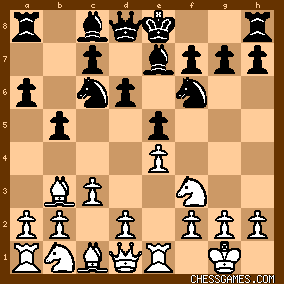
click for larger view8... Na5
See the commentary by <keypusher> concerning the comments by Soltis and Kasparov on the text in lieu of the now usual 8...0-0. Objectively, either move is fine, Kasparov's claim that 8...0-0 is "more accurate" notwithstanding. 9. Bc2 c5
10. d4 Qc7

click for larger view11. Nbd2
The usual choice here. But Winter's idea for White beginning with 11. a4 is also good. As Winter noted, Keres got a good game with 11. a4 against Reshevsky at Stockholm 1937 (and ultimately prevailed). 11... Nc6
Tarrasch (as reported by <keypusher>) shunned 11...cxd4 (or 11...exd4) as surrendering the center. <TheFocus> has provided us with Lasker's contrary assessment. Reinfeld explained Tarrasch's choice of 11...Nc6 as an attempt "to bring about a clarification of the Pawn position in the center." 12. h3
Kasparov calls this a "non-essential move, which returns us to a theoretical position" and prefers 12. d5. Reinfeld called the alternative 12. a4 the preference of "modern masters." Either 12. d5 or 12. a4 look good and seem to yield a small edge for White. Lasker's move, however, is hardly bad and afforded White at least equal chances, the position after the text being: 
click for larger view |
|
Jul-22-23
 | | beatgiant: <KEG> "Returns us to a theoretical position" says Kasparov? I think it's just out of fashion, not out of theory. For example, the position before move 12 appeared in the famous Capablanca vs F Duz-Khotimirsky, 1913, when Capablanca tried 12. Nf1. |
|
Jul-22-23
 | | KEG: <beatgiant>So far as I am aware, the position before 12. h3 was new at the time the game was played. It was reached a few times thereafter, most notably in Game 5 of this match, in Lasker v. Burn St. Petersburg 1909, and the Capablanca vs. Duz-Khitimirsky game you cite. it later became a favorite of Yates who scored five wins and a draw as White in six games from this position, and then won two games as Black from the same position after 11...Nc6 at Hastings 1919. The last time this position was reached was apparently in 1950 (Suetin-Lilienthal, USSR semi-finals). After 12. h3, there does not seem to be anything wrong with the White position and the subsequent sacrificial line chose in two games by Lasker in this match was--while not all that bad--entirely unnecessary if White is satisfied to obtain a decent, though not terribly dynamic--opening position. |
|
Jul-22-23
 | | beatgiant: <KEG> True about this specific move order (in our database at least), but after 12. h3 0-0, the game transposes back to a position for which the Opening Explorer shows hundreds of games, the earliest being Alapin vs Rubinstein, 1907, the latest being Zainab Asif Abdulah Al-Fayyadh vs Faratiana Raharimanana, 2020, and including a number of notable ones such as Reshevsky vs Smyslov, 1970 and Kavalek vs Karpov, 1970. Does this transposition introduce some important nuance? It's not obvious to me, but then I'm no openings specialist. |
|
Jul-23-23
 | | KEG: Post II
12... 0-0

click for larger view13. Nf1
"?!"--(Kasparov)(Schroeder)
"Offering a pawn for the sake of an attack." (Wilson)(see similarly Schroeder) "The text-move [was] an innovation...As Lasker [here and in Game 5] did not know how to take advantage of the sacrifice, he should have played 13. d5." (Hoffer) "A pawn sacrifice...[which Lasker] always maintained was sound." (Winter) "Lasker continues his development at the cost of a Pawn, apparently convinced he will later regain it without difficulty." (Reinfeld) "A dubious decision: now Black can simply grab a pawn." (Kasparov) The text leads to complicated play for both sides, which is undoubtedly what Lasker preferred. He perhaps banked on Tarrasch being discouraged after having lost the first two games of the match. Objectively, 12. d5 as given by Kasparov looks best. The position after 13. Nf1 was:
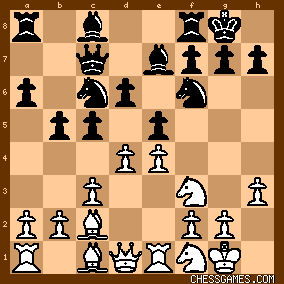
click for larger view13... cxd4
Unquestionably best for the reasons pointed out by Tarrasch (see the post by <keypusher>). "Tarrasch accepts the challenge." (Reinfeld)
14. cxd4

click for larger view14... Nxd4
Several commentators (e.g., Reinfeld; Winter) claimed that 14...exd4 was superior. Kasparov more moderately and accurately calls 14...exd4 "also good." Winter preferred the latter move in order to allow the c6 Black Knight to go to e5 in some variations. The choice between the two moves seems close and primarily a matter of style. Soltis says that the following trade of Knights "reduces White's kingside chances." 15. NxN exd4

click for larger viewThe dust has settled and we can take stock. Black has an extra pawn: the passed, isolated pawn on d4. That pawn was to live a charmed existence, with Lasker by-passing opportunities to grab it later. Ironically, this pawn was later to advance and Queen on move 35. But that was hardly foreseeable or even likely in the above-diagrammed position. All in all, Lasker had decent compensation for the sacrificed pawn at this stage, and the game was very much in the balance. Notably, both Lasker and Tarrasch were apparently satisfied with their respective positions here given that Game 5 mirrored this one move-for-move until this point. 16. Ng3
Lasker played 16. Bg5 here in Game 5. Since Lasker lost this game and won Game 5, many of the earlier commentators announced 16. Bg5 as an improvement: "In the fifth game, the better move 16. Bg5 was played here." (Hoffer) "This (16. Ng3) turns out unsatisfactorily. In the fifth game, Lasker adopted the stronger more 16. Bg5." (Reinfeld). Marco gave 16. Ng3 a "?", noting that Lasker [later] discovered the "better move 16. Bg5 and brought it out in the fifth game." Most notably: "Much stronger is 16. Bg5 as played in the fifth game. White must logically play to regain the pawn on d4." (Tarrasch). Kasparov, however, has refuted these earlier claims. Yes, 16. Bg5 worked wonderfully in Game 5, but that was because Tarrasch did not respond properly and instead played weakly. His actual 16...h6 has come in for more trashing than it perhaps deserves, but as Kasparov has shown 16. Bg5 Qc5! yields superior chances for Black. I will discuss 16. Bg5 in more depth when I get to Game 5. For now, suffice it to say that--the older commentators notwithstanding, Lasker's 16. Ng3 was not a mistake and was probably the best option for White here. Lasker did not lose this game because of 16. Ng3. He lost it because he got outplayed in the upcoming complications by Tarrasch. |
|
Jul-23-23
 | | KEG: <beatgiant> Yes, I overlooked the significance of the transposition and the frequency of the position reached here after 12...0-0. Thank you for this important correction. |
|
Jul-23-23
 | | perfidious: <KEG> there are numerous games in Opening Explorer which employ this older move order, but which transpose from C98 to C99 after h3 and ....0-0 are played. |
|
Jul-23-23
 | | KEG: <perfidious>Yep. I should have noticed this. Many thanks to you and to <beatgiant> for setting me straight. |
|
Jul-23-23
 | | KEG: Post III
16... Nd7
"Making way for the Bishop." (Tarrasch)(see <keypusher>) "A clever defense. The apparent risk of Nf5 is not to be feared, as the sequel shows." (Lasker)(see <TheFocus>). "An important move gained. It allows Bf6 and Nb8 or Nc5." (Hoffer) Kasparov correctly deems 16...g6 as inferior to the text, but his reliance on what transpired after that move in Euwe--Kramer, Match, 1941) is misleading. That game continued 17. Bb3 Qb6 18. Bh6 [White would be better and enjoy a small edge with 18. Bg5. The text allowed Black to regroup and achieve at least equality--KEG]. 18...Re8 19. Qf3 [A doubtful choice that was uncritically reported by Kasparov. White should just play 19. Rc1 with about equal chances--KEG] 19...Be6 20. Nf5 [and now, instead of Kasparov's recommended 20...Bf8--to which he appends a "!"--Black should play the natural 20...Nd7. Play then gets wild, but Black then seems fine even if he proves unable to hold onto the d-pawn indefinitely--KEG] After 16...Nd7, the position was:

click for larger view17. Bb3
"?!"--(Kasparov)
Kasparov analyzed 17. Nf5, which Euwe claimed was best, but Kasparov has shown that Black is "perfectly alright" after 17...Bf6 18. Re2 [hardly best, but Black is also OK after the stronger 18. Bf4 or 18. Bb3) Qb6 19. Rd2 Ne5 20. Nxd4 [regaining the pawn] Nc4 21. Rd3 Bb7 22. b3 and now Black has the slightly better chances with 22...Ne5 instead of Kasparov's wild and crazy 22...Bxe4?! which appears to lead to a difficult but probably even position. Interestingly, none of the commentators considers 17. b4, which is arguably best. 17... Qb6
Kasparov claims that 17...g6 is "also possible,' but I don't much like Black's prospects after 18. Bh6. Simplest and perhaps best here is 17...Ne5, which was not mentioned in any of the commentaries I have read. After 17...Qb6, the position was:
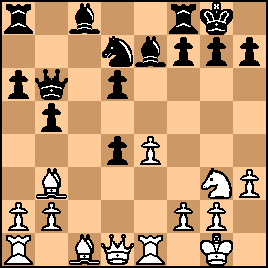
click for larger view18. Nf5
"The beginning of a King-side attack that fails. The positional play would have been 18. Bd5, followed by b3, Bb2 and the slow regaining by force of the d-pawn." (Lasker as quoted by <TheFocus>). Both 18. Nf5 and 18. Bd5 look reasonable to me. Perhaps even easier and a sounder road to equality an regaining the sacrificed pawn would have been 18. a4 bxa4 19. Bd5 Bb7 20. BxB QxB 21. Qxa4 g6 22. Qxd4. Lasker's actual move was the most dynamic route, putting pressure on the Black d4 pawn and preparing for a possible King-side attack. 18... Bf6
Practicaly forced, and leaving:

click for larger view19. Bf4
"?!"--(Kasparov)
Schlechter suggested 19. Bd5, and several commentators agreed with this alternative. But the follow-up is not so simple. After 19. Bd5 Ra7 20. b3 (Schlechter's line), Black can play 20...Ne5 (Tarrasch's idea) 21. Bb2 BxN 22. exB d3 and now after either 23. Rb1 (Kasparov's move; 23. Qd2 is also fine) Rd8 (another suggestion by Kasparov) leads to "more interesting" play after 24. Re3 (better than Kasparov's 24. Bc1). But the merit of 19. Bd5 is not found in the above proposed lines but rather with 20. a4 followed by 20...bxa4 21. Rxa4 Nc5 22. Rxd4 BxN 23. exB after which things get truly fascinating: 23...Nb3 24. Ra4 NxB 25. QxN Bxb2 after which White ultimately regains his lost pawn with a likely draw. Lasker's 19. Bf4 was also a sound--but more complicated choice. Lasker was clearly playing for another win, and the text seemed a good way to go about this, and would likely have brought success against a less formidable opponent. The key moments of the game were approaching. |
|
Jul-23-23
 | | KEG: Post IV
19... Ne5
"!"--(Kasparov)(Reinfeld)
"The proper reply." (Lasker)
The merits of the inferior 19...Be5 are well set forth in the post here by <keypusher>. After 19...Ne5, the position was:

click for larger view20. Bd5
Better, Kaasparov and Tarrasch notwithstanding, was the simple 20. Nxd4. Kasparov calls this move "greedy," and Tarrasch stated (as per <keypusher>) that "White can no longer win back the d-pawn with impunity." Tarrasch would surely have replied 20...Nc4 and then if 21. BxN BxN 22. Bd5 Black gets good chances with 22...Bxf2+ 23. Kh1 BxR 24. BxR Bb4 with decent winning chances because of the extra Black pawn. But, as Kasparov noted, White does better with 21. Ne2 (instead of 21. BxN). Kasparov then suggests 21...Be6, but White then seems fine after 22. BxN bxB 23. Rb1 since now 23...Bxb2? loses a piece to 24. Bc1. Black's only chance to obtain some edge in the above line lies in 21...Nxb2. But White still seems OK with 22. Qxd6 QxQ 23. BxQ with approximate equality. Returning to the actual game after 20. Bd5:
20... Ra7
The wild and crazy 20...BxN was the only legitimate way for Black to seek an advantage: e.g., 21. BxR Bxh3 22. Bd5 Bg4 and Black's two extra pawns for the lost exchange gives him some prospects. But this sort of line is much easier to pursue with computer assistance rather than over-the-board. Tarrasch's choice was certainly fine in practice as opposed to the laboratory. It left the position as: 
click for larger view21. Qb3
"White threatens to win with 22. Nxd4 QxN 23. Be3." (Tarrasch--see <keypusher>)(see Kasparov, similarly). But what about 21. Nxd4. Reinfeld diagnosed an edge for Black after 21. Nxd4 Nc4 22. Be3 NxB 23. fxN Bb7 [23...Rc7 would probably be even better--KEG]. But Reinfeld appears to have overlooked 22. Nc6 which leads to material and positional equality after 22...Rc7 23. b3 RxN! 24. bxN [better than 23...BxR 24. bxN RxN! 25. Be3!] Lasker's actual 21. Qb3 was not awful, but--as will be seen--it led him down a rabbit-hole which proved fatal against the precise defense of Tarrasch. 21... Rc7
"Taking the open file and at the same time parrying the threat 22. Nxd4 QxN 23. Be3." (Reinfeld) Tarrasch could equally well have played 21...BxN 22. exB and then 22...Rc7. After Tarrasch's actual 21...Rc7, the position was: 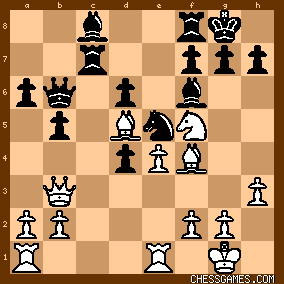
click for larger view<keypusher> reports that Shredder thinks the game was "close to equal" at this point. That seems a fair assessment, though Black, with an extra pawn at least for now, was obviously sitting better. I mention the assessment by Shredder which is approximately in accord with Stockfish (-0.39) and Fritz (-0.34) and which refutes the claim by Reinfeld that White here had to try "something drastic." Lasker, as we will see, did exactly that, and Tarrasch took full advantage. Contrary to Reinfeld's analysis, Lasker would have had excellent chances of holding the game with 22. Rad1 or 22. Rac1 (though, as pointed out by <keypusher>, Black would still have had the edge). But instead of simple sound play, Lasker went for a haymaker. |
|
Jul-24-23
 | | KEG: Post V
22. g4?!
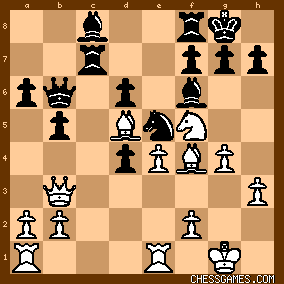
click for larger view"The attack initiated with this move is not without peril." (Tarrasch) Understatement of the year. After this wild effort, White will find it difficult to hold the game. "As the game is played,' White has now to stake everything on the attack." (Wilson). True, but only is 22. g4?! is played.
Until this move, play by both sides had been at a very high level. But now Lasker--perhaps because of the overconfidence I hypothesized in my first post on this game--went off the rails. Tarrasch may have been stunned on losing the first two games of the match; but not so stunned to overlook a golden opportunity to get on the board. 22... g6!
"Boldly forcing the issue." (Reinfeld)
23. Nh6+
An immediate 23. g5 would likely have transposed into what actually occurred. 23... Kg7
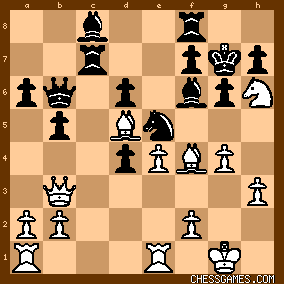
click for larger view24. g5
The main alternative, 24. Qg3, allows Black to get in 24...g5. White is committed to a do-or-die attack in either case, so the text--which somewhat limits Black's option--seems the best practical line. 24... Bd8
"The Bishop retreats all the way to permit the c7 Rook to guard the second rank if need be." (Reinfeld) 25. Qg3
"All this looks temptingly strong, but Black has a powerful parry in reserve." (Lasker from <TheFocus>). "A clever maneuver, playing the Queen first to g3, to bring it over to the King's side; but he can no more save the game..." (Hoffer) I am far from certain that calling Lasker's position lost at this point is fully warranted. He might also have tried 25. Kg2. But White was unquestionably on the brink of disaster. Lasker, of course, had saved--and won--many such positions in his career. But his opponent here was Tarrasch. 25... f6!

click for larger view"!"--(Lasker)(Kasparov)(Reinfeld)(Schroeder)
"A strong move, beating off the attack." (Tarrasch) "Black liberates his Rook and King's Bishop and assumes the [initiative]." (Lasker from <The Focus>). "An insignificant-looking little move which decides the game. [KEG--not quite--but pretty close]" An elegant move" (Schroeder).
"This powerful move, both for defense and attack, decides the game in Black's favor.
He deserves great praise for his accurate and economical defense, as well as for the forceful way in which he presses his counter-attack." (Teichmann). "This beats off the attack and makes it possible for Black to seize the initiative." (Reinfeld) "An accurate mover, bringing the opponent's activity to a standstill." (Kasparov) From here, as I will discuss in my next post on this game, Lasker threw all caution to the wind. He might just have been able to survive with 26. gxf6+. But by this point Lasker was apparently in full attack mode, and shunned half-way measures. |
|
| Jul-24-23 | | generror: <RookFile: <This is a wonderful game. You don't seem games like this in world championship play these days.>> True, until Nepo and Ding duked it out in 2023 :) I do like Carlsen, but I'm really glad he declined to defend his title. I know many people have critized them to play badly, but both went for the craziest compliations and even on the top level, it's not easy to find the right moves without an engine... Looking forward to your next post, <KEG>! I really like that you include the relevant annotators. I'd love to do that myself, but I'm just too lazy and impatient. You should bring your kibitzes out as a book, I would totally buy it! Best way to play over the games :) |
|
| Jul-24-23 | | generror: <RookFile: <This is a wonderful game. You don't seem games like this in world championship play these days.>> True, until Nepo and Ding duked it out in 2023 :) I do like Carlsen, but I'm really glad he declined to defend his title. I know many people have critized them to play badly, but both went for the craziest compliations and even on the top level, it's not easy to find the right moves without an engine... Looking forward to your next post, <KEG>! They're really well written and I just love that you include relevant annotators of the past, giving you more than just one opinion. I'd love to do that myself, but I'm just too lazy and impatient. You should publish your kibitzes out as a book, I would totally buy it! |
|
Jul-24-23
 | | KEG: <generror>So glad you like the game and my posts. The Lasker-Tarrasch match was, for the most part, at a very high level. It was arguably the first "World Championship" match in which the two strongest players in the world faced off. Nobody could seriously have thought in 1907 that Marshall was superior to Tarrasch (who had mauled him 8 games to 1 two years earlier), and Steinitz was well past his prime in his two matches against Lasker But in 1908, the Lasker-Tarrasch match (even though Tarrasch was a bit past his prime) was a truly legitimate World Championship match, and had Tarrasch prevailed, he would rightly have been deemed the World Champion. For this reason, I disagree with you in that I would have preferred to see Carlsen defend his crown. Nobody thinks that Nepo and Ding were the two best, and Ding's victory--much as I enjoyed the games--hardly establishes him as the world's best chessplayer. |
|
| Jul-25-23 | | generror: <KEG: <For this reason, I disagree with you in that I would have preferred to see Carlsen defend his crown. Nobody thinks that Nepo and Ding were the two best, and Ding's victory--much as I enjoyed the games--hardly establishes him as the world's best chessplayer.>> Sure, I understand that point of view, but I have a different one. To me, a title is just that: a title. It is something awarded by society, a status symbol, a construct, an abstraction, and thus a simplification. A title doesn't necessarily say something about the holder. There have been who many who arguably were the best player of their time but have never been world champion. Rubinstein, Fine, Reshevsky and Korchnoi have all been the top-rated player according to ChessMetrics for a while, but they never had the honor of being called World Champion. Others like Alekhine and even my beloved Lasker held the title even if they probably weren't the "best", at least for a while. Furthermore, I'm not really interested in the "best". I just don't believe that concept has any value. "The best is the enemy of the good", as I keep saying. I was glad not to see a perfect match with extremely good chess, and I liked both players took risks and didn't play it safe. But again, that's just my point of view. Feel free to disagree :) |
|
Jul-25-23
 | | KEG: Post VI
26. Nf5+
"!?"--(Reinfeld)(Kasparov)
"Lasker still tries for a 'swindle.' " (Reinfeld) This may well indeed have been the best practical chance (i.e., that Tarrasch would respond 26...gxN?). But what were the alternatives. 26. h4, as Reinfeld and later Kasparov have shown, would be bad: e.g., 26...fxg5 27. hxg5 (27. BxN+ first is an improvement on the lines given by Reinfeld and Kasparov, but hardly a panacea) RxB! 28. QxR Bxg5. That leaves 26. gxf6+. Kasparov was surely correct that White is still much worse then after 26...Bxf6 [actually, 26...Rxf6 is probably superior to Kasparov's move], but the position would hardly be one in which resignation would be in order. After the text, by contrast, Lasker's only realistic chance was that Tarrasch would blunder. Please not the report by <keypusher> that Shredder's evaluation for White dropped by more than a pawn after Lasker's last move. In any case, the position after 26. Nf5+ was:
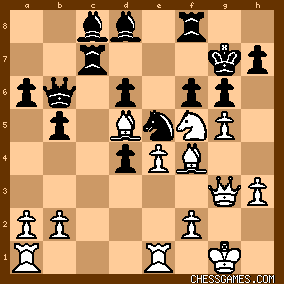
click for larger view26... Kh8!
As nearly all of the commentators have pointed out, 26...gxN would have allowed Lasker to draw after 27. gxf6+ Kh8 (of course not 27...Kxf6?? 28. Qg5 checkmate) 28. Bh6 Rff7 (forced) 29. BxR RxB 30. Rg7+Kg8 etc.. But Tarrasch was not likely to fall for this. As he said "I only considered taking the Knight for the blink of an eye..." (see <keypusher> for Tarrasch's full comment). After 26...Kh8, Lasker had to decide how to follow up his attack, the position now being: 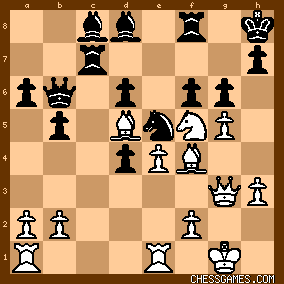
click for larger view27. Nh4
"?"--(Reinfeld)
"Alas, forced." (Kasparov)
In fact, Lasker had several options here. But all of them were bad. Lasker said he should have continued with 27. gxf6 and 28. Nh6. Reinfeld agreed with this assessment. But all agree with Tarrasch that even after 28. Nh6 "the attack could not be maintained." Similarly, 27. Nh6 fxg5 28. BxN+ dxB would be nearly hopeless for White. Thus, while I cannot agree with Kasparov that 27. Nh4 was "forced," I also cannot agree with Reinfeld that it was a blunder. It was one of several awful options open to Lasker and--as will be seen--an option that gave Tarrasch chances to go wrong. 27... fxg5

click for larger view28. Bxg5
Although not mentioned in any of the commentaries I have seen, this was far from best, and from here Tarrasch made short work of Lasker. The best chance to resist was almost certainly 28. BxN+ dxB 29. Nf3, though now after 29...g4! 30. Nxe5 gxh3 White would be down two pawns with scant hope of saving the game. Lasker no doubt saw all this, and thus chose the trickiest line still available to him. 28... BxB
28...Rc2 also almost certainly would be winning for Black. 29. QxB

click for larger view"Now White threatens to drive off the Knight, which has been dominating the game for the last 10 moves, via f2-f4." (Tarrasch as per <keypusher>). The manner in which Tarrasch dealt with White's threats is instructive, and a pleasure to play over. |
|
Jul-25-23
 | | KEG: <generror> I think you have stated your case nicely and succinctly. There have certainly been times when the top two players did not meet for the title, and times when neither of the top two played in the world championship match. Yes, it would have been great to have seen Lasker square off against Pillsbury (who might have given him a tough match) and Rubinstein (who I suspect Lasker would have crushed in a match of any length). In the case of Reshevsky and Korchnoi, they had their chances to play for the title and fell short. Reshevsky took 3rd-4th in the 1948 tournament (losing three times to Botvinnik), and later fell short in two Challenger's tournaments and then lost matches to Portisch and Korchnoi. Korchnoi was (with the possible exception of Keres), probably the finest player never to become world champion. But he lost three matches to Karpov and later got thumped by Kasparov. As for Fine, he would likely have been a tough match for Alekhine, but he chose to by-pass the 1948 World Championship tournament. We should probably just agree to disagree on this point about who should play in the world championship matches and just get back to analyzing and enjoying the play of all these superstars of chess. |
|
Jul-26-23
 | | KEG: Post VII
29... d3
"!"---(Kasparov)(Schroeder)(Reinfeld)
"The decisive move." (Tarrasch)
"Decisive. I continued the game merely to see in what manner Tarrasch would now force the win." (Lasker as per <TheFocus>) "A catastrophe on f2." (Kasparov)
"White might as well resign now. His game is hopeless." (Hoffer) The text was indeed a crusher, though I am surprised that nobody has mentioned that 29...Rc2 (with d3 in the offering as required) was even simpler. In any case, the situation was indeed awful for Lasker after 29...d3: 
click for larger view30. Kh1
Passive defense was hopeless. If 30. Qg3 Rc2 (Tarrasch)(Reinfeld)(Kasparov). If 30. Rf1 Bxh3 (Tarrasch)(Kasparov) or perhaps even simpler: 30...Rc2. If 30. Re3 Bb7; if 30. Qe3 QxQ and White has no chance in the ensuing endgame. "Lasker, as always, chooses the line which affords the best tactical chances." (Winter). 30... Rc2
30...Qxf2 also wins as explained by <keypusher>. 31. Re3
"He must prevent Qxf2." (Winter)
As most of the commentators pointed out, 31. f4 would be destroyed by 31...Qf2 which would leave White in a mating net from which there would be no escape. 31... Rfxf2
"With the terrible threat of 32...Rh2+ 33. Kg1 Rhg2_ 34. NxR Nf3+ winning the Queen." (Reinfeld) Tarrasch's comments to the contrary notwithstanding, 31... Rcxf2 was perhaps even more brutal. After Tarrasch's 31...Rfxf2, the position was:

click for larger view32. Ng2
"The only move." (Tarrasch).
As Tarrasch also pointed out, if 32. Nf3 White gets annihilated after 32...RxN! 33. RxR [what else!] Rh2+! 34. KxR NxR+ winning the White Queen (and the King soon thereafter). 32... d2
"The gambit pawn becomes the margin of victory." (Schroeder) Note the nasty little trap Lasker had set. As pointed out by Winter, if Tarrasch had taken his eye off the ball for even a moment and grabbed the Knight with 32... RxN, Lasker would have ended the game with 33. Qf6 Checkmate. How difficult it was to win even a clearly won game against the always resourceful Lasker. But this sort of joke was unlikely to get anywhere against the likes of Dr. Tarrasch. After 32...d2, Lasker faced the following sickening situation: 
click for larger viewEven here, Lasker had--as we shall see--a few tricks still up his sleave. 33. Rg1
33. Rg3 looks more natural, but at this point Lasker was hunting for tricks and traps. 33... Rc1
"The position is ripe for resignation." (Reinfeld) 34. Qe7
"The last remote chance." (Winter)
Had Lasker played the obvious-looking 34. Bb3, Black could have won with 34...Nc4 or with 34...RxR+ 35. KxR Nf3+ 36. RxN RxR+ (a painful discovered check) 37. Ne3 QxN+ 38. QxQ RxQ. Lasker's actual 34. Qe7 left:
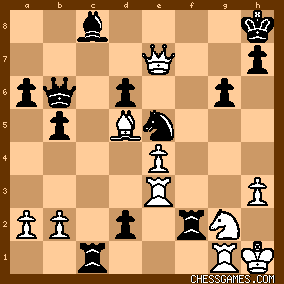
click for larger view |
|
Jul-26-23
 | | KEG: Post VIII
34... RxR+
One of many ways to win. Other ways would begin with 34...d1(Q) or 34...Rff1. 35. KxR d1(Q)
36. KxR Qf3+
37. Ke1

click for larger view37... Qa5+
This was more than sufficient to win, but Kasparov chides Tarrasch for missing the mate he is sure Alekhine (who showed his wizardry with two Queens in the 11th game of his match against Capablanca) would have seen: 37...Nd3+ 38. Kd2 Qa5+ 39. Kc2 QxN+ and mate in two. 38. Rc3 Bxh3
38...Nd3 was again quicker.
39, Qxd6

click for larger view"Black is again threatened with mate, but his attack hits home first." (Reinfeld) 39... QaxR+
Kasparov claims that 39...Qg3+ would have been faster. I don't see that at all, but the issue is of little consequence since Tarrasch's line brought the game to a speedy conclusion. 40. cxQ Qxc3+

click for larger viewTarrasch was now only two pawns ahead, but his overwhelming attack made all that quite irrelevant. 41. Ke2 Qc2+
42. Ke3 Qd3+
43. Kf4 g5+
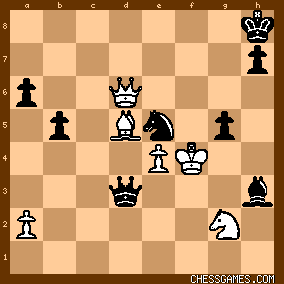
click for larger viewIf now 44. Kxg5 then 44...Qg3+ 45. Kh5 Bg4+ 46. Kh6 Nf7+ wins the White Queen. So Lasker decided to call it quits.
0-1
"The challenger has raised his head! Now much depended on which of the two players would success in landing the next blow." (Kasparov) The spectators would not have long to wait to find out who would strike next. Lasker would win Game 4 (the final game played in Dusserdorf), and then--after the match shifted to Munich--would win two of the next four games, with three games being drawn. This would leave Lasker ahead by five wins to one (with eight wins required to prevail). The balance of the match (in which Lasker won three of the final seven games, lost two, and drew two) only confirmed what games 1 through 9 had shown about the relative strengths of the contestants. Lasker learned from his loss in Game 3, and controlled the balance of the match. |
|
Jul-26-23
 | | offramp: Many thanks, KEG. An interesting game. |
|
Jul-26-23
 | | KEG: <offramp>It certainly was a fascinating game. And Game 4 of the match, which I have just begun analyzing, appears at first blush to be even more fascinating. |
|
 |
|
< Earlier Kibitzing · PAGE 2 OF 2 ·
Later Kibitzing> |
|
|
|





